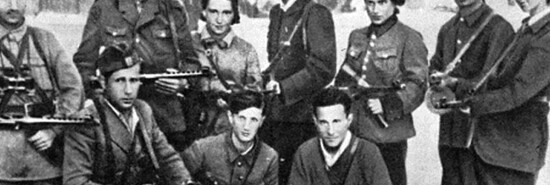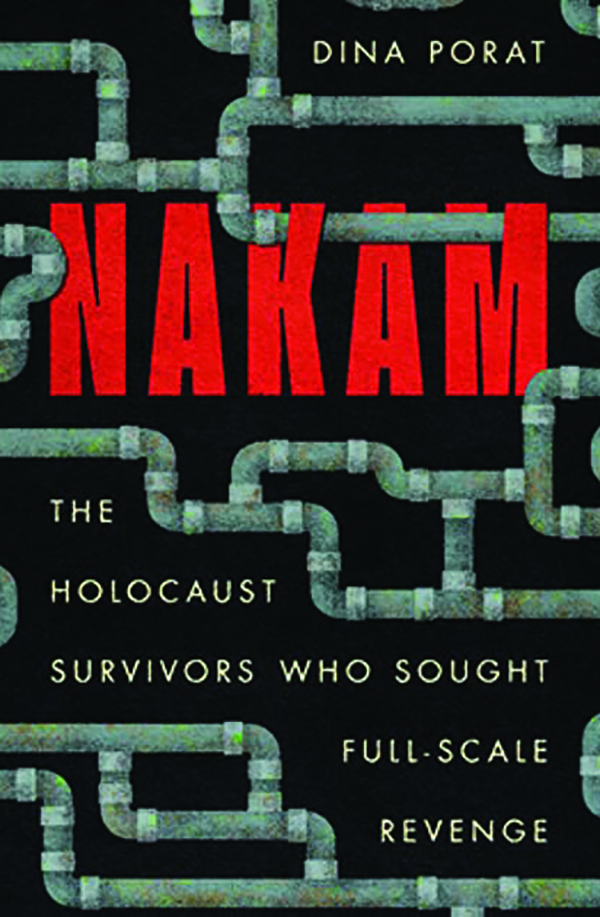
Avenging the Holocaust
Michael M. Rosen
“My name is Shosanna Dreyfus,” declares the protagonist of Inglourious Basterds as she prepares to incinerate a Paris cinema full of Nazi officers, “and this is the face of Jewish vengeance!” The popular 2009 Quentin Tarantino alt-historical film gave vent not only to a general punch-a-Nazi ethos but to the particular desire of many Jews who saw their families perish in the Shoah to exact revenge against the evil perpetrators.

In real life, there was a group of Jewish Holocaust survivors who once set out to enact vengeance on Nazis and Germans writ large, along the way raising profound philosophical and prudential questions about justice, punishment, and retribution. Known in Hebrew as the “Nokmim,” a term that translates to the Avengers, they started in the mid-1940s. Dina Porat’s cogent and chilling Nakam is the first book-length study of the Nokmim.
It’s part riveting tale, part scholarly disquisition. Porat thoroughly and sensitively interrogates their motivations, their tactics and strategies, and the ramifications of their highly controversial actions, which never fully materialized. Carefully incorporating dozens of interviews with the now-nonagenarian remnants of the group, Porat, a renowned Holocaust scholar and onetime chief historian of Israel’s Holocaust museum, adroitly surveys the origins and ultimate futility of the innate human instinct for revenge.
Led by Abba Kovner, a charismatic Polish Jew who had spearheaded resistance in the Vilna Ghetto before escaping to the forests in 1943 to join the anti-Nazi partisan militia, their overall objective was clear. “They wanted vengeance that would stand as the overt response of the victimized nation against the murderers, vengeance that would strike the Germans in specific but warn the rest of the world that Jewish blood would never again be forfeited as it had throughout history and, above all, during the Holocaust.”
The group of determined men and women began to amalgamate in early 1945 in newly liberated Lublin, in eastern Poland, as the war raged on further to the west and the opportunity to strike back presented itself. They had different motivations: fulfilling the dying wishes of relatives; the intensity and immediacy of the moment; the guilt of the survivors; the dawning recognition of the immense scope of what only then became known as the Holocaust; the aftermath of visits to the death camps; and the resurgence of anti-Jewish violence, even as Nazi forces retreated. This “fear that the Holocaust would continue,” Porat reckons, represents “the underlying basis, the foundation,” for their actions.
The Nokmim, along with the Zionist organizations with which they loosely affiliated, soon migrated to Romania and then northern Italy as Polish authorities began to suspect their malign intent. Kovner united the group around a credo: “We assume the duty to make forgetting impossible, and will do so by means of the necessary deed: reprisal. This will be more than vengeance. It must be the law of the murdered Jewish people!”
Reprisals were to go far above and beyond targeting individual Nazi soldiers. The Nokmim began developing two parallel schemes involving poisoning water systems: Plan A, to taint the aqueducts in major German cities such as Frankfurt, Hamburg, or Munich to kill 6 million Germans; and Plan B, to doctor water supplies in prisoner-of-war camps, thereby executing tens of thousands of imprisoned Nazi officers.
In August 1945, Kovner set sail for Palestine in search of monetary, material, and rhetorical support for his plan from Zionist officialdom, at the time immersed in the fight to establish the Jewish state. The leaders of the government-in-the-making, known as the “Yishuv,” grudgingly provided all three, although they explicitly rejected Plan A, fearing it would trigger a furious backlash that might impede Jewish statehood. But trouble ensued as Kovner, bearing milk cans filled with poisonous powder and toothpaste tubes choked with gold coins, was detained by British authorities while returning to Europe and relegated to prisons in Egypt and Jerusalem. (While Kovner and other Nokmim suspected Yishuv dissidents of sabotaging them, Porat definitively demonstrates how unlikely this would have been.)
Meanwhile, the Haganah, or Jewish army-in-formation in Palestine, dispatched Nahum Shadmi, its European commander, to Paris, where the Nokmim had regrouped, in order to co-opt their mission, which was hurtling toward its targets: Nazi POW camps in Nuremberg and Dachau. A few members clandestinely acquired a sizable quantity of arsenic in early 1946 and smuggled it to Munich in rubber hot-water bottles. Under cover of darkness, on April 13, three Nokmim burgled their way into the kitchen in Nuremberg and smeared thousands of loaves of bread with the arsenic mixture. The result: Thousands of German prisoners suffered food poisoning, but none died, likely because of insufficient concentration of poison. “Despite the momentousness of Jewish vengeance as a principle,” Shadmi lamented, “these results are negligible.” Shadmi also scrubbed the parallel Dachau operation at the last minute on the basis of “unanticipated technical reasons.” Porat surmises the Americans policing the camp may have uncovered their plans.
Following these setbacks, the Nokmim hatched ill-developed plots to execute some or all of the Nazi war criminals on trial in Nuremberg, none of which came to fruition.
With Allied police forces on their trail and the Haganah eager to focus its energies on preparing for independence, the Nokmim were exhorted to decamp from Europe to Palestine. Kovner, too, from his cell in a Jerusalem prison, urged them to redeploy to the Holy Land, where they could reorganize and rebuild their infrastructure. Rank-and-file members reluctantly agreed. “For a while, until the time comes to continue the project of vengeance,” one wrote, “we are moving to the Land of Israel.” And while they never seriously advanced their project thereafter, the majority of the Nokmim played important military and social roles in the early emergence of the Jewish state.
Other Jewish leaders at the time channeled the powerful desire for revenge into symbolic and more productive ends. Moshe Sharett, who would become Israel’s second prime minister, traveled to Italy in April 1945 to boost the morale of the Jewish Brigade, which comprised troops from Palestine and Europe and was doggedly engaging Nazi soldiers. Proudly brandishing the brigade’s flag, which prominently featured a gold Star of David, Sharett characterized the standard as “the banner of our vengeance against the enemy, as a symbol of the redeemed honor of our slaughtered brothers who could not turn back the battle at the gate.”
Golda Meir, who would later serve as Israel’s fourth prime minister, similarly invested her vengeful instincts in the Jewish fighting force. “I want each German man, each German boy, each German Nazi to see the Jews as Hebrew soldiers from the Land of Israel, and part of the very army that conquers their country,” she declared. “If that’s vengeance, then it’s the vengeance that I want.”
Along the way, Porat thoughtfully explores the ambiguous philosophical underpinnings of vengeance in Jewish law, secular tradition, and Holocaust literature. While the Torah enjoins the Israelites that “thou shalt not avenge, nor bear any grudge, against the children of thy people,” it also expressly condones and even encourages “nekamah,” or revenge, against cruel, hostile nations that seek to destroy them.
“Revenge is a kind of wild justice,” Sir Francis Bacon wrote in 1696, “which the more man’s nature runs to, the more ought law to weed it out.” Primo Levi, a chemist and writer who survived the death camps, contended that “every German must answer for Auschwitz,” while Simon Wiesenthal, another survivor and successful Nazi hunter, titled his memoir Justice, Not Vengeance.
Ultimately, Porat pinpoints what she calls vengeance’s “inherent contradiction”: “The conscience demands vengeance because vengeance is inflicted at the behest of the murdered; however, vengeance in the form of annihilation offends the conscience.” One wishes to believe that it was reasons of conscience and not just practical obstacles that prevented the Nokmim from compounding the horrors of the Holocaust by committing further atrocities, however justified they may have felt in the moment.
Michael M. Rosen is an attorney and writer in Israel and an adjunct fellow at the American Enterprise Institute.
